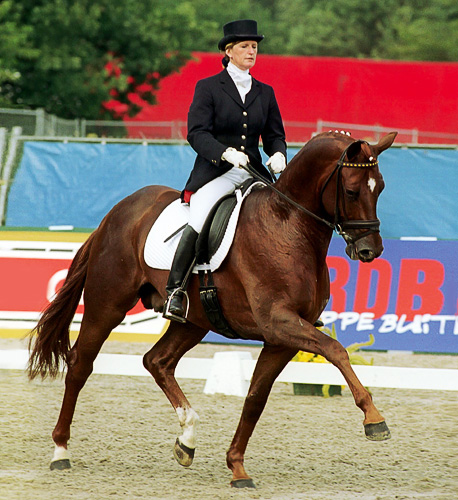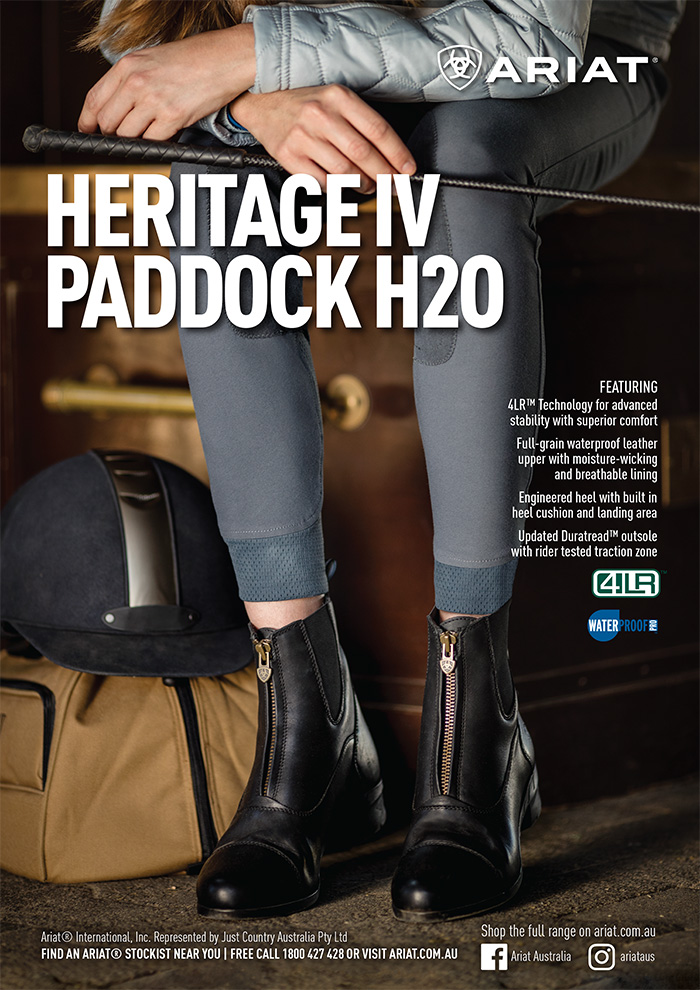by Christopher Hector
Every year about this time I look forward to receiving the translation of Dr Ludwig Christmann’s annual survey of the German breeding values, this year particularly so, since it seems that the breeding values are multiplying rapidly. Once upon a time there was a single German FN value, based on the BLUP model, which has been used to calculate everything from milk production in dairy cows, this I think was its first use, to the likelihood of a volcano explosion. It is just not such a useful tool when it comes to evaluating horse breeding and identifying the best stallions.
The BLUP system gained most power in France where it dominated the selection of licensed stallions, and provoked stern criticism from the famed breeder, and journalist, Bernard le Courtois. Writing in 1994, six years after the introduction of BLUP to French breeding, he was of the opinion:
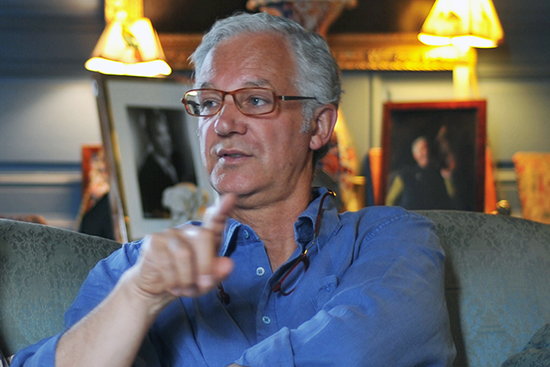
“In the beginning I was optimistic concerning the BLUP; even though I have always been convinced that nothing can replace experience and observation and the know-how of a horseman. Today, with hindsight, I am aware of the system’s aberrations as well as the way in which it has been abused.”
Le Courtois asserts that his judgment “is drawn from professional experience: as a stud farmer, owner, judge, dealer and most of all as a breeder passionately involved in sport horse selection.”
He is also well aware that the pressure for some sort of ‘objective’ guide comes in part from the phasing out of the traditional breeders to a new generation of ‘town’ breeders. This is compounded by a National Stud staffed by “executives who do not have the practical training their predecessors received, thanks to present modes of recruitment and training.”
“Many newcomers in the horse world grabbed onto BLUP like a childishly simple life-buoy. Suddenly they felt on an equal par with the professionals, imagining that this index would make up for their lack of knowledge, without realising that they were fooling themselves. They hid behind the BLUP, believing it would protect them.”
Bernard turned to the evidence of the scientist, Professor Signoret: The principal PRINCIPLE of the BLUP method is excessively simple, even simplistic. It affirms a priority that a foal that is born will, providing all else is equal, represent an average between his father and mother. Breeders, genetic specialists, and those involved in improving domestic breeds know that, generally speaking, this is not the case. Only milk production is the happy exception confirmed by experience.
“It turns out that the equine BLUP index is nothing more than an adaptation of the American milk BLUP index!”
story continues below advertisement
I have written a series of articles over the years, pointing out anomalies in the ‘numbers’, young stallions would appear from no-where, high on the rankings, then disappear just as rapidly, while established sires with excellent progeny on the ground would languish at the bottom of the tables, if they made them at all.
Seemingly those in charge realised the rankings were not perfect because the German FN changed the system, there were now two tables, one based on progeny performance in young horse classes, one on senior competition results. It was an improvement, though there were still some whacko results. This year, there are three sets of tables – let Ludwig explain the changes of this year’s charts:
The new breeding value works
With great anticipation, we waited for the results of the breeding value estimation of the German Equestrian Federation. After all quite a few changes had been implemented. The biggest difference is the insertion of a new breeding value called “Highest Achieved Level”.
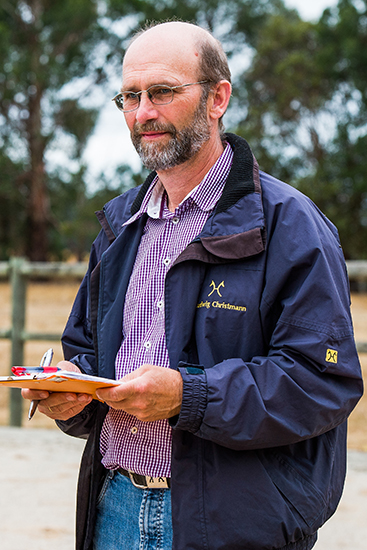
By Dr. Ludwig Christmann
This article first appeared in Der Hannoveraner January 2020
A few changes were implemented for jumping horses in the breeding value estimation of young horse classes. The scores, which were obtained in mare and stallion performance tests as well as in jumping and dressage horse classes for young horses, are now the basis for the breeding value. In the past, stallion performance tests and mare tests were valued separately. This has now been simplified; they are calculated together.
Furthermore, for the first time, the results from the three-day sport test for stallions were integrated.
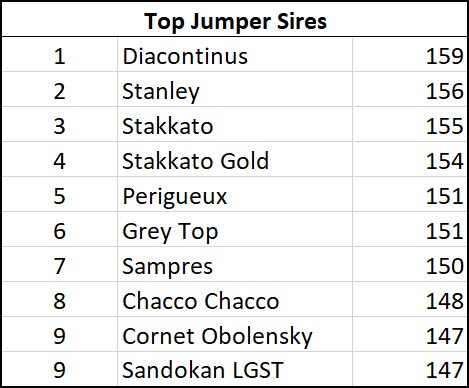
The list of the top ten jumping stallions, which were rated the highest nationwide, shows a strong dominance of Hannoveraner stallions. Just like last year, Celle’s state stud sire Diacontinus by Diarado/ Contendro (breeder: Klaus Jürgens, Sehnde-Bolzum) is leading the way. Breeders of Hannoveraner horses used him a lot last year. Even though his oldest descendants are now only five years of age, 61 stallions and mares, which were evaluated in performance tests, and 148 horses, which participated in young horse classes, offer a broad basis for a reliable breeding value estimation. Numerous descendants of Diacontinus already successfully compete in jumping horse classes at the M-level.
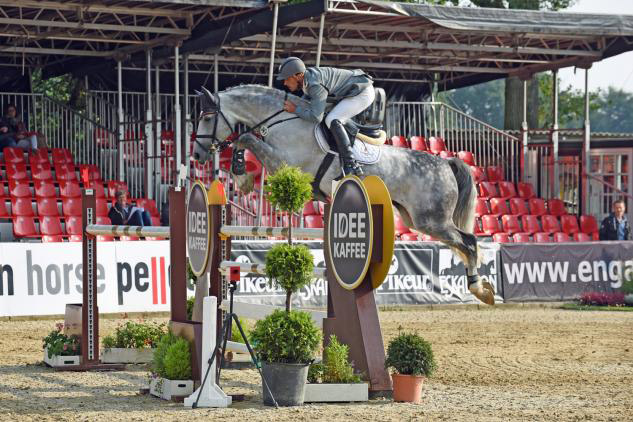
Diacontinus heads the list…
The genetics of Stakkato especially imprint the list of top jumpers though. Stakkato himself continues to be in the top group. His sons Stanley, Stakkato Gold, Sampras and Sandokan LGST join him. Regarding Perigueux, we find Stakkato as the dam’s sire.
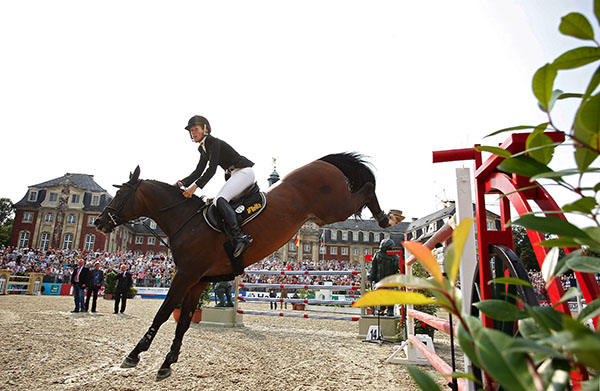
Stakkato – his influence is huge
In the young horse jumping classes, Stakkato and his descendants benefit from the very good technique. Bascule, technique, carefulness and absolute performance willingness are the attributes, which Stakkato reliably passes on.
story continues below advertisement
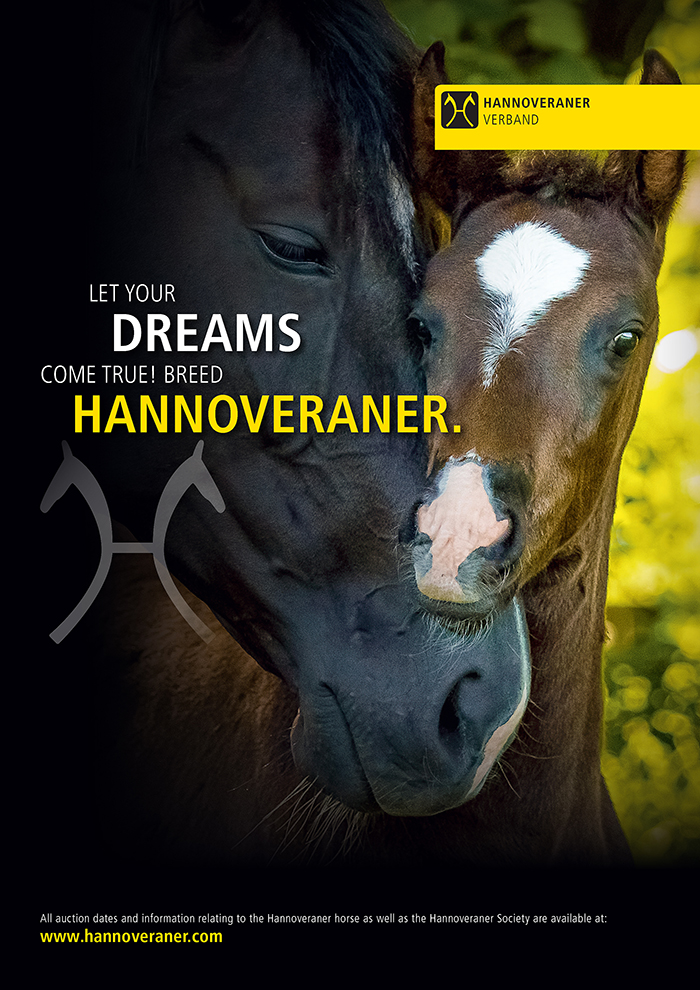
Celle’s state stud sire Stanley by Stakkato/Loredo (breeder: Wilfried Berg, Burgdorf; line of Adda) often stood in the shadow of other sons of Stakkato during the past years. His performance predisposition is very well secured on the dam side of his pedigree via Loredo, Graphit and Gotthard. His dam line is one of the best, which the region of jumping horses Burgdorf-Hänigsen has to offer. Eighty nine descendants of the 2006-born stallion successfully competed in jumping classes for young horses, twelve were evaluated in breed classes. His oldest descendants are now eight years of age; several of them already have successes at the S-level. Premium aspirant Sally probably is one of the most successful. She is out of a dam by For Edition. Bonja Bormann already won numerous classes at the S level with her including international 2* jumping classes in Neumünster/GER and Uggerhalne/DEN.
The 2008-born Sampras by Stakkato is one of the newcomers in the top ten. Dr. Jacobs GbR bred him in Bierbergen. On the dam side, Sampras has a very interesting pedigree with Achill-Libero H (That’s the official name for Libero H), Calypso II and Furioso II. The stallion Wallenberg, who stands at the breeding farm VDL in the Netherlands, is his full brother.
The breeding farm Callaho in South Africa had bought Sampras on Verden’s foal auction. He completed a good 70-day test and stood at stud on the breeding farm Famos for two years before he moved to South Africa. He only produced a few descendants, which are very successful.
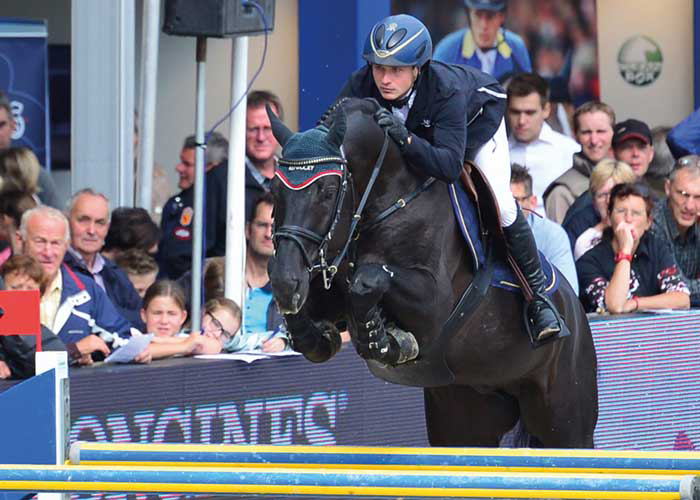
Sandoken – a national champion
Sandokan LGST by Stakkato/Landor S (breeder: Hans-Werner Schubert, Kötze) is out of the superior dam line of Norm. In 2013, Sandokan LGST was the national champion of five-year old jumpers with rider Eva Bitter. His oldest sons in competition are five years of age and have successes in jumping horse classes up to the L-level.
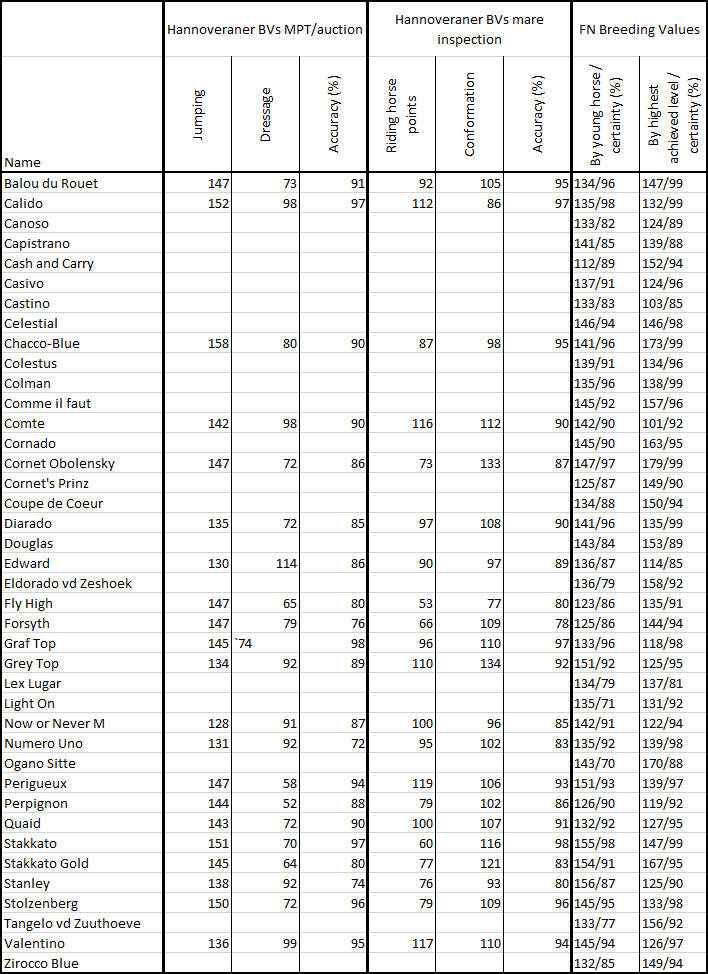
Producers of international calibre
It becomes increasingly more apparent that Hannover has a stallion of international calibre in Stakkato Gold (breeder: Arend Kamphorst, Prieros). The stallion, which is stationed at Stud Sprehe, is among the highest graded producers in every type of breeding value estimation. He is among the top ten in the breeding value estimation of young horse classes and, with his breeding value Highest Achieved Class (be patient, Ludwig will unravel the mysteries of this new class later in this article) of 167, he ranks among the top one percent in this particular breeding value estimation method.
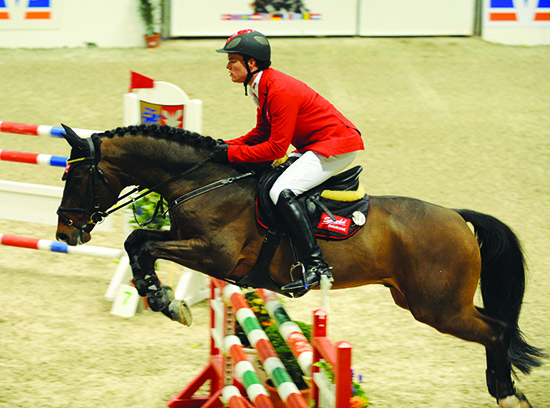
Stakkato Gold – a sire of international calibre
Last year, he was the best German stallion in the FN-breeding value estimation for competition.
His heredity is no coincidence, if you look at the pedigree of his dam. There you not only find performance producers like the Hannoveraner Stallion Of The Year Werther, but also Achill-Libero H and Calypso II. The dam Wertherroeschen successfully competed at the international level up to 1.60 m. Already numerous internationally successful horses descend out of the dam line of Algave. Stakkato Gold offers a good transition to competitions.
Story continues below the advertisement
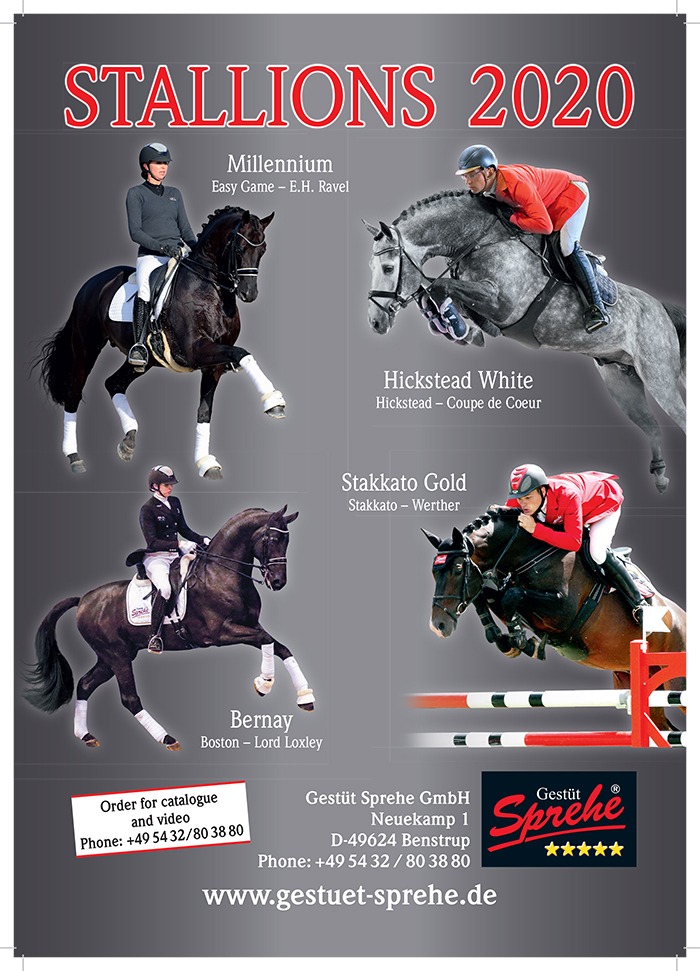
The German Riding Federation publishes three breeding values: young horse classes, competitions and the new breeding value called highest achieved level (HEK). To keep the clarity, we do without the breeding value competition in the extensive chart. Instead we list the new breeding value highest achieved level (HEK) in the charts.
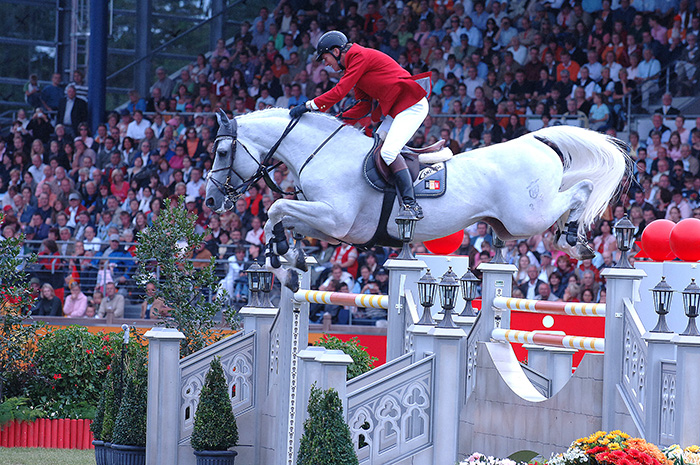
Cumano – top of the tops
The Holstein stallion Cumano, which became the world champion in Aachen/GER with rider Jos Lansink in 2006, holds the lead of the top ten in the breeding value HEK. Even though he does not have the largest number of descendants, but a large percentage of his offspring are successful in international competition. Nine out of 30 descendants have successes at the S***-level, three at the S****-level.
The top ten list otherwise is a mirror image of the competition situation, with which not only the Hannoveraner horses but also the entire breeding program of German jumping horses are faced. Only two stallions on this list were stationed in Germany: Cornet Obolensky and Chacco-Blue.
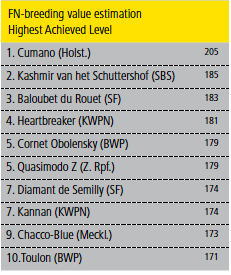
The others were used or originated in Belgium, France and the Netherlands. They are stallions, which are well known as producers of horses of international calibre.
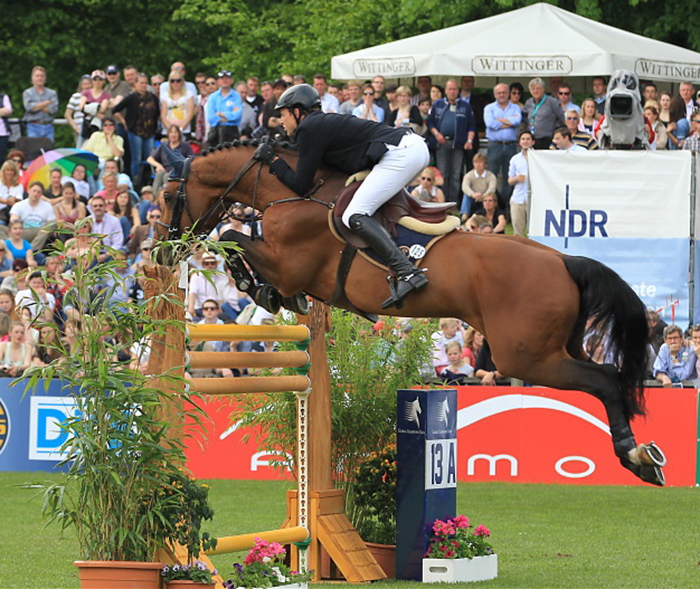
Chacco-Blue: top producer
Chacco-Blue is a great example that the new breeding value highest achieved level has the desired result. With a breeding value of 173, Chacco-Blue is identified as a top producer for international competition. It confirms his leading position in the list of producers of the WBFSH. His breeding value competition is 138. Even though this is also clearly positive, it does not certify exceptional heredity.
The situation with For Pleasure is similar. The breeding value highest achieved level of 161 reflects much more how his offspring perform in horse shows all over the world than the breeding value for competition does, which is estimated at 139.
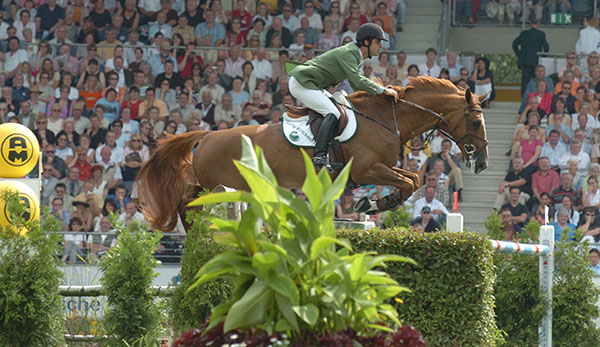
Baloubet – great stallions are not always great young horse sires…
Baloubet de Rouet is an example that the results in jumping horse classes do not always make a statement about the successes in international competition. His breeding value young horse classes is estimated at 126. As a producer of international sport horses, the Olympic champion from Athens/GRE has a HEK-breeding value of 183 and with that belongs to the top group. The results of 266 descendants were entered into his breeding value estimation young horse classes. In spite of this, both breeding values are important and meaningful. In addition to jumping ability, the style at the fences and the rideability are crucial in the young horse classes. In upper level competitions, ability, fighting spirit and smartness are of utmost importance.
Story continues below the advertisement
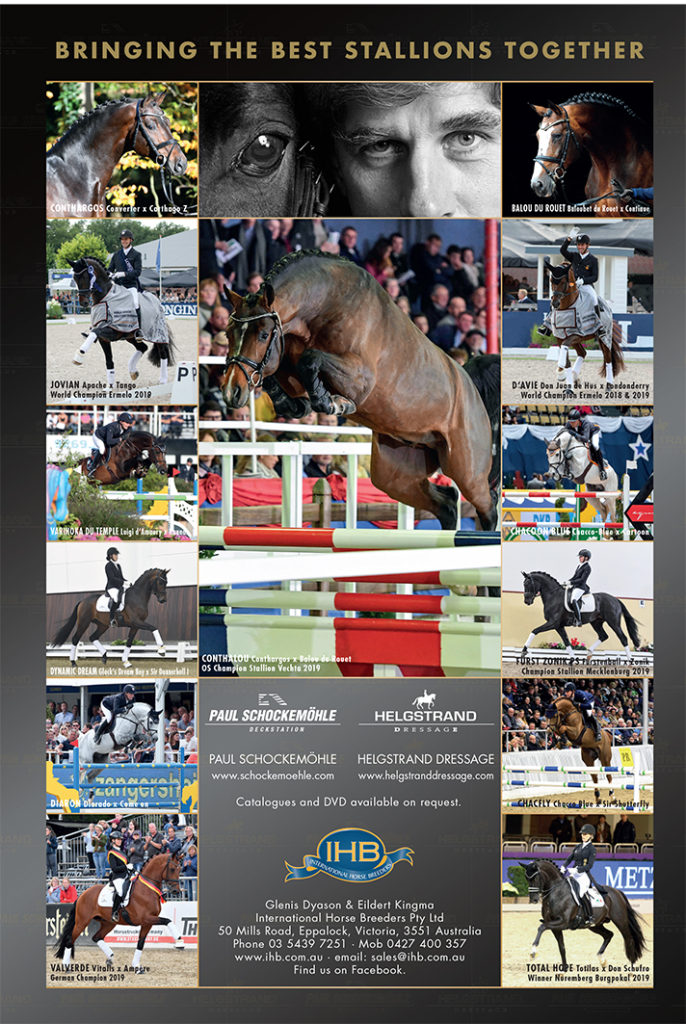
Dressage Rankings
Just like last year, the Westphalian stallion Escolar by Estobar NRW/Fürst Piccolo (owner: Gut Neuenhof, Nideggen) is the highest graded dressage sire with a breeding value young horse classes of 167. With rider Hubertus Schmidt, the expressive bay stallion is one of Germany’s greatest hopefuls in the large dressage arena. The same counts for his heredity.
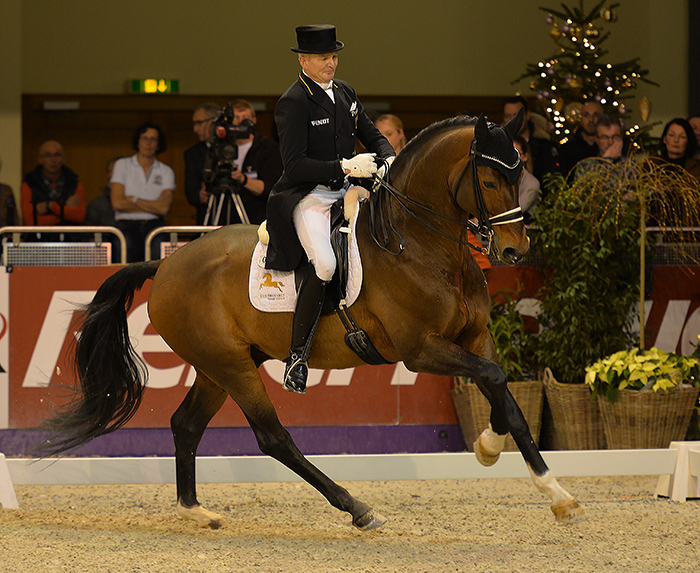
Escolar – number one again
We can now already observe that Escolar gave the Hannoveraner line of the Thoroughbred stallion Adeptus xx, which got to Westphalia via the 1969-born Ehrensold by Ehrenschild, a lift.
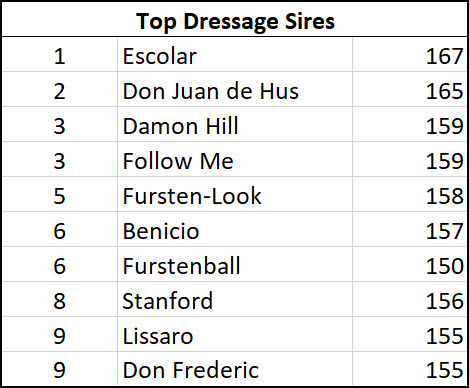
Four Hannoveraner stallions are among the highest valued: Fürsten-Look, Benicio, Lissaro and Don Frederic. The presence of Fürstenball in this top group is striking. He is listed as well as his two sons Fürsten-Look (breeder: Johannes Sabel, Gersten) from the stallion station Schockemöhle, the national champion of four-year old stallions in 2015, as well as Follow Me from the Dressage Horse Performance Center in Loeningen.
Christopher Hector comments: Once again Lissaro features in the top line up of dressage sires, despite that fact that breeders were so unimpressed with his progeny that he was withdrawn from stud to make an honest living as a young rider mount. I’ve seen a few of his progeny, sweet creatures, but without that spark that makes a dressage horse – I would have thought, given Lissaro was bred to jump and indeed jumped successfully at a young horse level, foals out of jumping mares with lots of blood, might be great eventers…
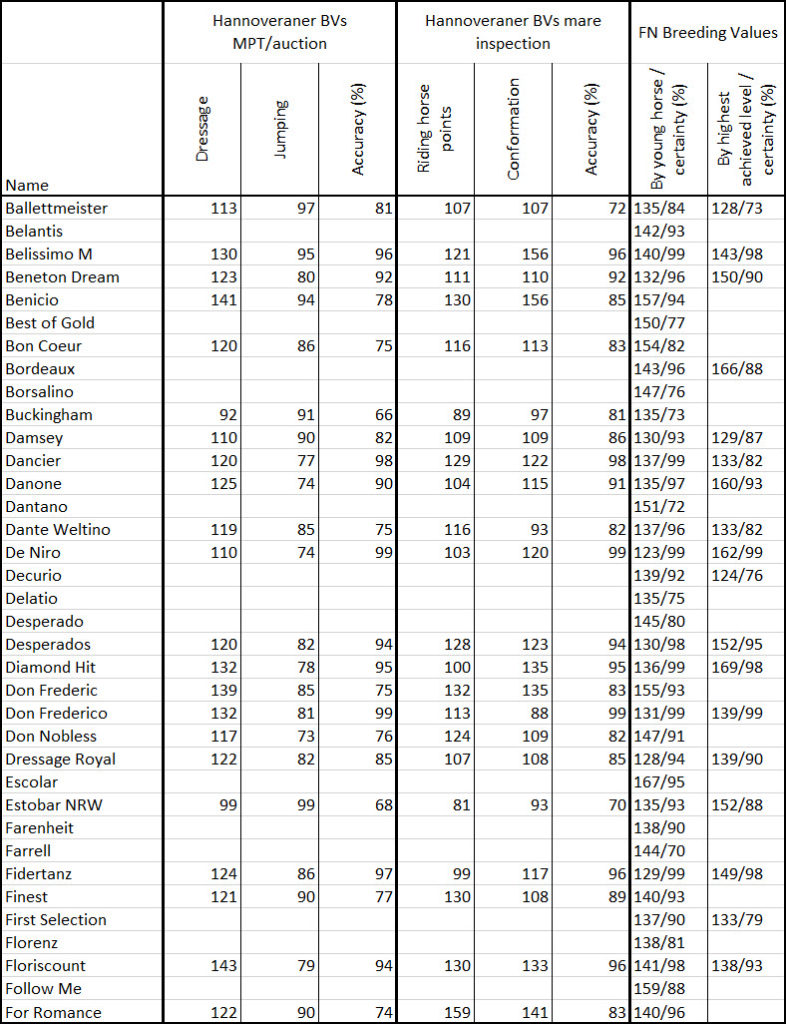
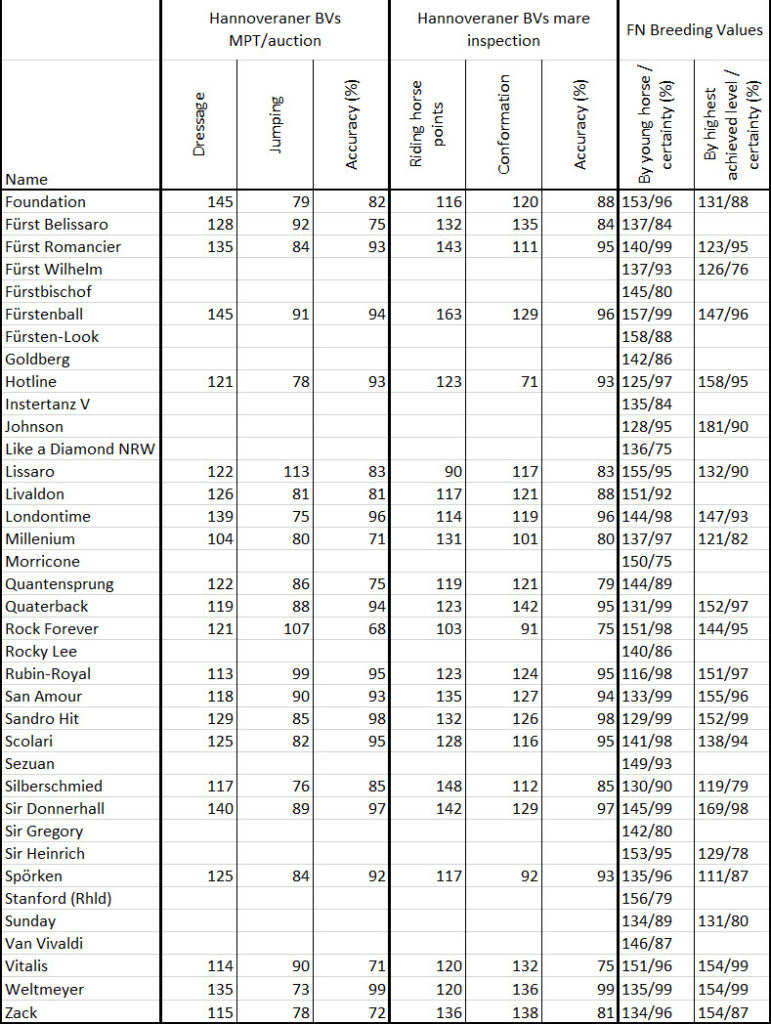
Stanford, bred in the Rhineland by Anton and Uwe Mengelaers, Geilenkirchen, reached the publishing threshold for the first time, which required a security of 70 percent for the FN-breeding value estimation. As a three-year old, this son of Sir Donnerhall/ Diamond Hit finished the National Championships for German riding horses in third place with rider Stefanie Wolf. The following year, he again was a finalist. He also became a finalist as a five- and as a six-year old at the World Championships for young dressage horses in Verden, where Dorothee Schneider presented him. He obtained his best result in 2015, when he finished in fourth place.
Later on, Matthias Bouten rode Stanford to victory in dressage classes at the S-level. He stood at stud at ‘Krüsterhof’, the farm of Johann Hinnemann in Voerde. Stanford’s high rating does not surprise the former breed manager in the Rhineland, Martin Spoo: “The line of Fanfare is one of the best in the Rhineland region. The foundation dam Fanfare by Cyrus was originally imported from Hannover. Stanford has been a fantastic horse from the start and sired many striking foals in the Rhineland.” His most successful son so far is Sole Mio, which was licensed in Verden and which sold to the USA, where he won the US-Championships for young dressage horses in two consecutive years. Stanford is no longer serving as a breeding stallion.
Don Frederic, by Don Frederico/Wolkentanz (breeder: Beate Wedermann, Wangerland) often passes on great moving potential to his descendants. He also impresses with his heredity of a good type and good exterior.
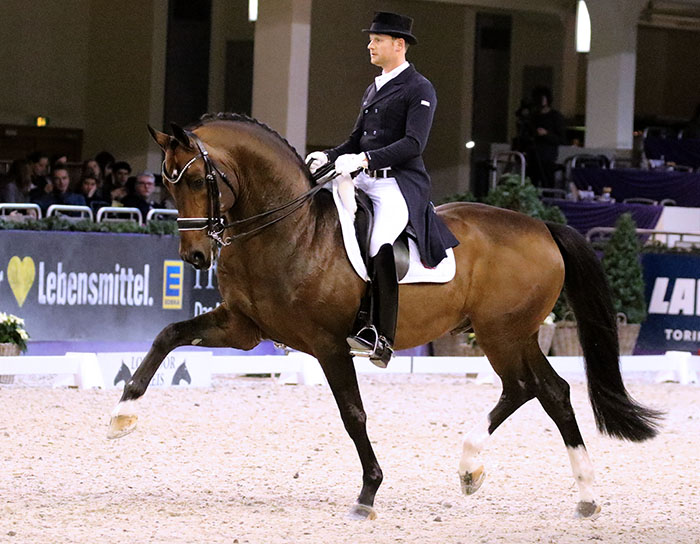
Foundation – competitor and sire
His stable mate on the Schafhof is the stallion Foundation by Fidertanz/De Vito (breeder: Gerd Pigge, Lastrup). Foundation follows Don Frederic with 153 points. He also established himself at the Grand Prix level with his rider Matthias Alexander Rath. Don Frederic, as well as Foundation, confirm their good evaluation from the previous year.
story continues below the advertisement

Two newcomers lie between the two stallions with 154 points. They are First Ampère and seven-year old, black Bon Coeur by Benetton Dream/Sandro Hit (breeder: Birgit Tietjen, Taaken).
As a producer, Bon Coeur is one of the biggest positive surprises of the last two years. Already in 2018, his first sons generated a lot of enthusiasm on the licensings. As three-year olds, they fulfilled all expectations under saddle. From this first vintage, his son Bon Courage became the vice national champion of three-year old stallions with rider Jessica Lynn Thomas. Many of his daughters received high grades in mare tests, which led to the high breeding value of the black stallion. We now only hope that the logistics will work and that he will be able to be used in Lower Saxony, even though he now lives at Loevsta Stud in Sweden.
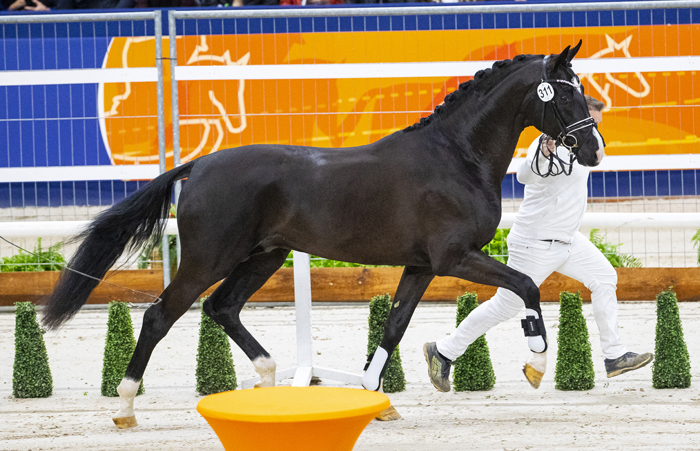
A Bon Coeur colt at the KWPN licensing – super!
First Ampère by Ampère/Weltruhm (breeder: Jan Siemsglüss, Bomlitz) obtained the equal high breeding value of 154 just as Bon Coeur. Over the past years, the bay stallion (owner: Breeding Farm Nymphenburg, Bad Zwischenahn) was an excellent advertisement for the Hannoveraner Verband. At the Bundeschampionat in Warendorf in 2014, Eike Bewerungen rode him into third place. As a five-year old, he finished the Bundeschampionat for dressage horses also winning bronze.
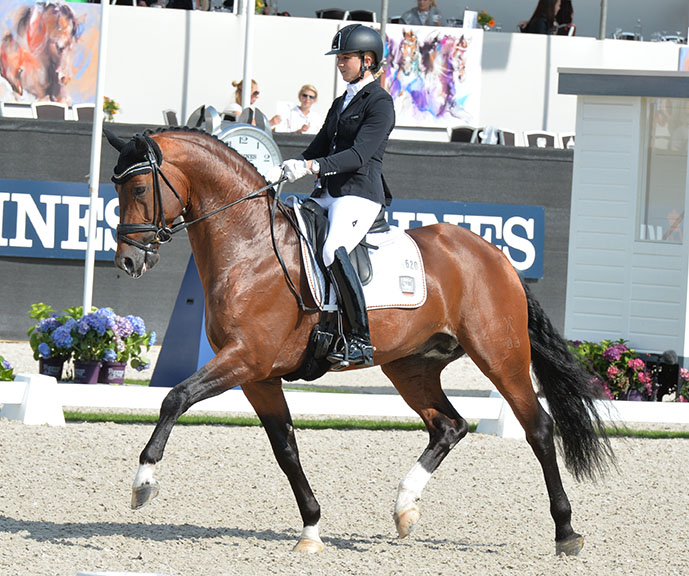
First Ampère – reprosenting Hanover at the Worlds
He represented the German and Hannoveraner colors three times at the World Championships for young dressage horses in Ermelo/NED from 2016 until 2018 with rider Tessa Frank. He became a finalist each time and placed well. Now Cosima von Fircks competes First Ampere. She seamlessly links up with the preceding successes. She has already won several dressage classes at the S-level with the now just eight-year old stallion, for instance on the Nations Cup show for young riders in Mariakolnok/HUN.
“During the past years, the emphasis was on First Ampère’s development and training. Many breeders inquired about him, but we had to turn them down. In the future, he will not only compete, but also be used for breeding,” says his owner, Freiherr von Fircks.
In addition to his own successes, the results of seven four-year olds in young horse-classes and two in breed classes (mares/stallions) contributed to his breeding value.
story continues below the advertisement
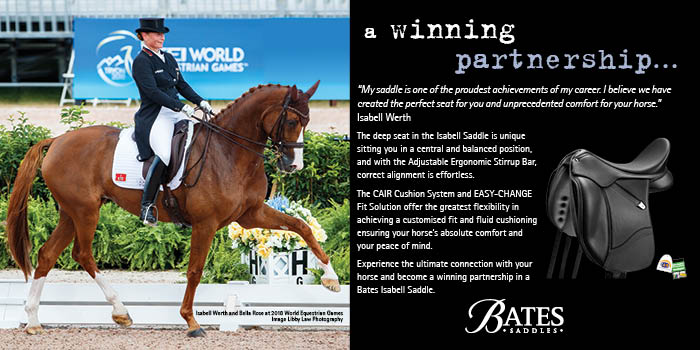
Highest Achieved Level
Many important horses from international dressage horse breedings meet in the group of the top ten of the breeding value estimation highest achieved level.
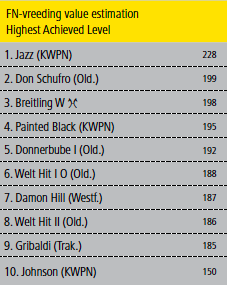
Leading the way is the Dutch star producer Jazz followed by Don Schufro and the Hannoveraner Breitling W.
In the several decades I have been looking closely at the breeding values, Breitling W is perhaps the only instance when the numbers drew attention to a relatively obscure stallion that was achieving great results. CH
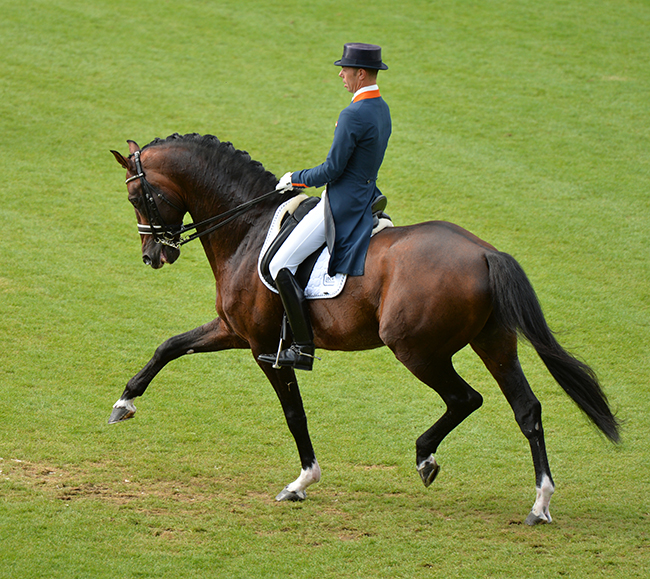
Johnson, the youngest in the top group
The youngest stallion in this top group is the Dutch stallion Johnson, a son of Jazz. Johnson was born in 2002. With Hans Peter Minderhoud, he was on the Dutch team, which won the gold medal at the European Championships in Aachen in 2015. By now, Johnson also causes a great stir as a producer of international dressage horses. The list of WFBSH producers has him in second place. Seven of his descendants are among the top 100 in the world rankings.
The Hannoveraner stallions Wie Weltmeyer, born 1990, and Dimaggio, born 1995, are among those stallions, which are valued as the best 1 percent.
Wie Weltmeyer by Weltmeyer/Dynamo (breeder: Volker Bachmann, Fassberg) was a successful Grand Prix horse. With rider Emma Hindle, he represented Great Britain and won the bronze medal with the British team at the European Championships in Hickstead/GBR in 2003. He sired only a few descendants, relatively speaking. In the Hannoveraner yearbook for stallions in 2018, he was listed the last time with 116 descendants, which were registered in Hannover. A total of 66 offspring participated in competitions, 52 of them as dressage horses. Twelve of those obtained successes at the S-level. Wie-Atlantico de Ymas was probably the most successful with numerous international Grand Prix successes with rider Anders Dahl from Denmark.
Dimaggio, by Don Primero (breeder: Ralf Hollwedel, Syke) was the world champion of young dressage horses in 2000 with rider Suzanne Lavandera. His last breeding station was the Stallion Station Böckmann. He was in high demand until his death in 2015 and produced numerous horses with successes at the Grand Prix level.
Lord Loxley (Rhineland by Lord Sinclair) follows closely with 167 points. He too was rated very highly. This stallion – out of a dam by Weltmeyer – became the vice world champion of young dressage horses in 2004 with rider Jana Freund and only a few weeks later, he was the Bundeschampion of five-year old dressage horses. This popular, powerfully moving stallion was out of the breeding program of Breeding Farm Sonnenhof in St. Vith, Belgium, where he also stood at stud at the end. He produced numerous horses for top-level dressage.
How does the new breeding value highest achieved level classify De Niro by Donnerhall/Akzent II (breeder: Brigitte Pahl, Fockbek)? His breeding value in this new breeding value estimation lies at 162, which places him very close to the top one percent of the best stallions (169 and better). The show results of more than 1,100 descendants were examined. 29 of them successfully competed in dressage at the S****-level and three at the S*****-level.
The result of the first round with this new breeding value, called highest achieved level is as follows: The experiences are positive; the classification is comprehensible. It especially applies to stallions, which produced horses for international competitions. The above-mentioned examples show that stallions with a relatively small number of descendants have a chance in the breeding value estimation and not only in the breeding value highest achieved level. After all, the breeding value estimation considers the performance of every participating or successful horse. If a stallion has a lot of descendants, it raises the probability that many of them only successfully compete in the lower levels. This can conceivably have a negative effect on a breeding value.
This is different to the stallion rankings of the WBFSH, which only take into account the top descendants of a stallion. There, stallions, which are used heavily for breeding, have an advantage.
story continues below the advertisement
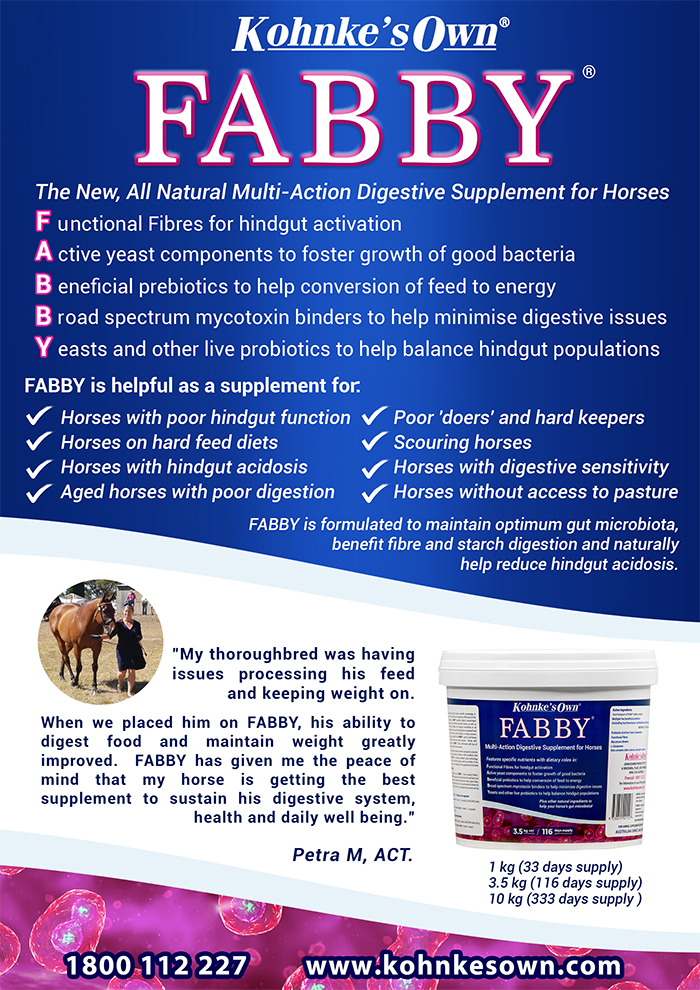
The new breeding value called highest achieved level
The reason for the development of the breeding value “highest achieved level” (HEK) was the impression that the international successes of descendants were not sufficiently considered. From the Hannoveraner perspective, it affected the top producers De Niro and For Pleasure. Therefore the committee of the German Equestrian Federation, which deals with the breeding value estimation, worked out a model, in which the evaluation criteria for the breeding value is the highest level, which a horse reaches in his horse show career.
A chart was developed, which reflects the performance level of jumpers as well as dressage horses. The points in the chart above can be obtained, if a horse confirms the performance ability three times. The point chart starts with successes at the A level. Once a horse has participated in classes at the A-level three times, it receives a point.
If the horse placed between second and fourth position at the A-level a total of three times, a bonus of 0,3 is added. There is an additional bonus for victories at the respective level, but again only if there are three victories. The chart differentiates especially at the upper levels between S* and S*****. The highest points that a horse can obtain are 8,6, and that is, when it has a minimum of three victories at S***** classes. Only one value for each horse is entered into the breeding value estimation, while this value can improve throughout the horse’s career.
For the first time and only in this particular new breeding value, international show results, which the International Equestrian Federation (FEI) provided, are considered for the breeding value estimation. The breeding value is estimated in accordance with the proven rules of the BLUP breeding value estimation. This means that all available information about relatives is included, that there is basis for comparison and that fixed effects are integrated, which may influence the performance. The sex of the horses, the age at the time of the last competition and the age, at which the first HEK-breeding value estimation was done define such effects.
The new model of the breeding value estimation was carefully tested, before the first results were published. Viktoria Welker from Dresden wrote her doctoral thesis about this subject at the University Halle-Wittenberg. The title is “Estimation of the parameters regarding the population genetics in the breeding of riding horses with special consideration to the innovative attribute definitions for horse show-performances”. She confirmed that the new attribute “highest achieved level” is well suited for the breeding value estimation and as a selection tool. The estimated heritability is remarkable, which is 0,22 for dressage and 0,37 for jumping.
With respect to the new attribute, she concluded, “Compared to the transformed rank (note: previous estimation criterion), specific statements about the performance ability and about the genetic predisposition of the horse for his use as a sport horse at a high level can be made.”
– Dr. Ludwig Christmann
I must confess that I was somewhat amazed when the new HEK dressage values were revealed. Overall, it is a goodly line-up of stallions with proven progeny, but there in the middle, ranked fifth, is Donnerbube I, a stallion I remember well from his time in Martina Hannöver’s training stables. The bay stallion was a sweet horse, but perhaps not the ideal model for a breeding stallion. Since then Donnerbube has gone on to have a distinguished career with the glamorous Italian, Sylvia Rizzo, his final competition results were in Doha in 2013, where he placed 11th and 12th in the GP and the Kür, before that his best result was a third in a 3* Freestyle at West Palm Beach. Donnerbube was obviously a great traveler, in 2011 alone, he fronted the judge at C in Mechelen, Stockholm, Lyon, Milan, Wroclaw, Hickstead, Vierzon, Pompadour, Compiègne, Hagen, Saumur, Vidauben and Vejer de la Frontera. Whew! But as a sire? I cannot recall one of his progeny at any level and I asked Ludwig if he could explain this apparent anomaly. This was his response:
Donnerbube certainly is a surprise in this list. He also was presented for licensing as a 9-year-old for Hannover, but did not pass. The new breeding value, however, gives an indication for the genetic potential to pass on the talent for the higher classes. Looking closer at the facts, Donnerbube is not so impossible:
He did a very good performance test in Warendorf with an index of 131 in dressage, which made him 2ndout of 23. He started his career with a very good pedigree value. Donnerhall anyway, his dam Pik Dame produced seven dressage horses, three of these competing at S-level and up.
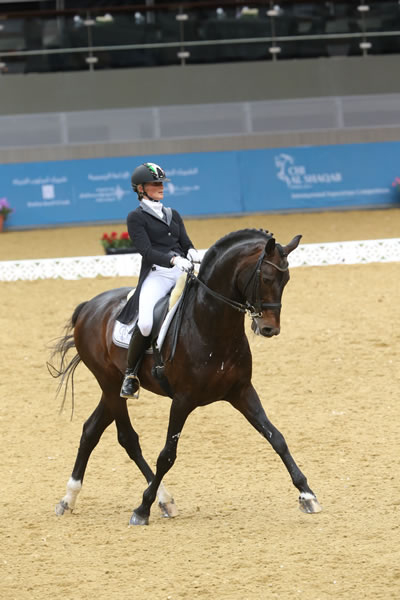
Donnerbube and Silvia Rizzo
He did not produce many horses, just around 60 were born in Germany, but more than half of his offspring were successful in dressage competitions, three were successful in S*** competitions. One of his S-successful offspring was out of a Thoroughbred mare, so the mare did not contribute so much.
I beg to differ, arguably the most successful dressage dam in Germany is Wolfram Wittig’s Devisa, by the Thoroughbred Diego and with 63.28% ‘blood’.
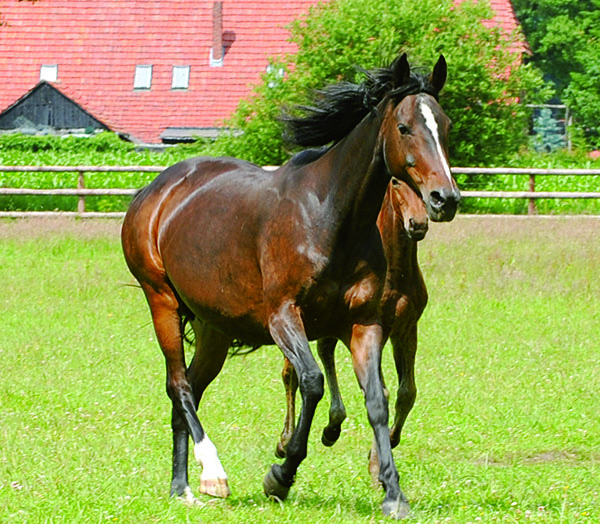
Devisa – the best dressage broodmare of them all?
Devisa is the dam of five Grand Prix competitors, two at St George… According to Horsetelex, Donnerbube is the sire of two GP horses – Sophie Wells’ Diomedes (Flamenco) and Daiquiri (Justinian xx) ridden by the Italians, Anna Paprocka-Campanella and Leonardo Tiozzo.
Back to Ludwig:
Based on the low number of offspring the reliability of Donnerbube’s breeding value is pretty low with 74 % and his own performance still has an influence. This low reliability indicates, that the breeding value might change with more offspring information.
Of course he would never make it into the international WBFSH rankings with this small number of offspring. When you look at these rankings thEn it is dominated by stallions who produced masses of horses. Donnerbube certainly has not been the super stallion, but he is an example, that the breeding value system may point to stallions, who bred less mares – an example in the rankings of the jumping stallions is Cumano.
Again I beg to differ…
Cumano is a really different proposition from Donnerbube, in that he produced international superstars and basically from one crop since fertility problems dogged him later in his career. Cumano spent one season in France in 2000 when he was seven years old and this was perhaps the most productive season of any stallion, anywhere, any time, in the world!
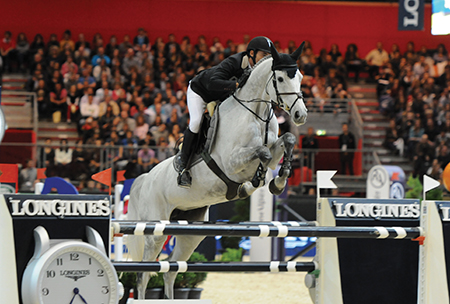
Nasa – just one of the stars by Cumano
He produced 61 foals that year out of fairly ‘normal’ mares, eleven of whom gained jumping indices of 150 or more, SIX of whom have won CSI classes. They include Steve Guerdat’s Nasa (out of a mare by Prince d’Elle) – 2nd at Calgary in 2013; Nectar des Roches (Count Ivor xx) fourth at Vichy*** with Edouard Couperie; Nenuphar’Jac (Pidayack), a consistent GP performer with Michel Robert, and with his retirement, with Penelope Provost; Neptune Brecourt (Kayack), 10th at the 2013 European Championships with Lucia Maria Moneta; Newton du Haut Bois (Quat’Sous) 2nd in a 1.45 at Calgary with Cameron Handley. Then we have Noblesse des Tess (Irake) who was 4th at the London Games with Kamal Bahamdan, and Notre Moinerie (Qredo de Paulstra) double clear in the 2nd placed Swiss team at Lummen Nations Cup with Carlo Pfyffer.
The search for the Holy Grail
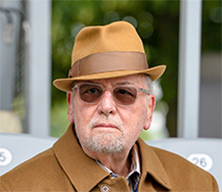
a commentary by Christopher Hector
All over the breeding world it seems the search for the perfect mathematical model goes on. For many the holy grail seems to be calculating successful competitors as a proportion of foals born. Thus the KWPN has recently calculated their stallion standings on the basic of S level competitors to total progeny and as with the new German HEK standings, it produces some whacko results.
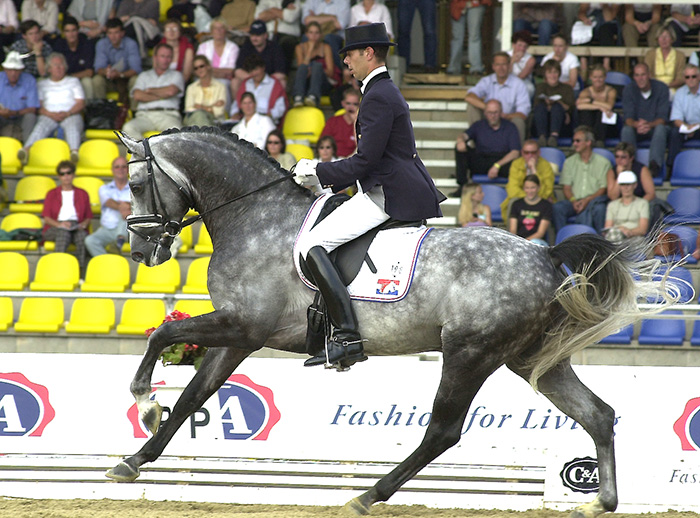
Rubels wins a World Young Horse title with Hans Peter Minderhoud
On these figures the number one dressage stallion is former young horse champion, Rubels (Rafustinsels / Amethist) who has eleven out of 107 offspring at S level, 10.3%, the most successful of which is Hans Peter Minderhoud’s Grand Prix horse, Zanardi (Avignon). Zanardi was recently placed fifth in the Freestyle and eighth in the Grand Prix at Doha. He best result in 2019 was a win at Geesteren 3 star with a score of 78.725.
Second on this ranking is Jazz with 9.5% of his foals going on to S level, but while I had to search the database to find Rubels’ top representative, we can all easily name super competitors by Jazz.
Third spot to Paganini, and now the worth of this new ranking is starting to look very shaky indeed. Paganini (Havidoff / Statuar) was a moderately successful Grand Prix horse with Bert Rutten before he was sold as a competition horse to Canadian, Cheryl Meisner. The KWPN assessment of his progeny in Holland was not enthusiastic:
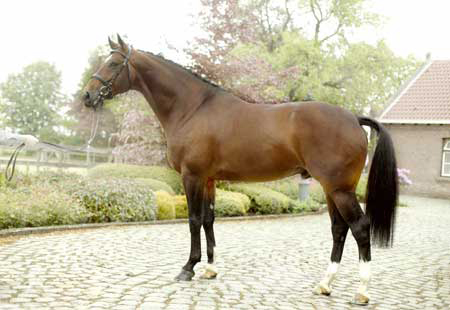
Paganini – the THIRD best stallion?
“Paganini showed a uniform group ample developed foals who are sufficient to more than sufficient riding type. In trot, the hind leg should be brought under more. In movement the foals should have more length of stride and more suppleness.”
And of those S level competitors that rocketed the stallion into third place, only one appears to have gone Grand Prix, the mare Aida H (Pericles xx) who competed with Enrico di Vico in a GP at Omago (ITA) back in March 2019, for a score of 62.391%. Enough said.
Really I think we are back where we started with Bernard: “nothing can replace experience and observation and the know-how of a horseman.”
Still I guess calculating the numbers provides gainful employment to numerous breed society functionaries, and endless fun for bored equestrian journalists deprived of our usual fodder of equestrian competition, locked down because of the virus… Stay safe, stay home, stay kind my friends, see you on the other side of this terrible time.
Thanks again as always Ludwig, your knowledge enriches us…
Do you want to breed to Europe’s finest stallions? You can with frozen semen from IHB – just check them out here
